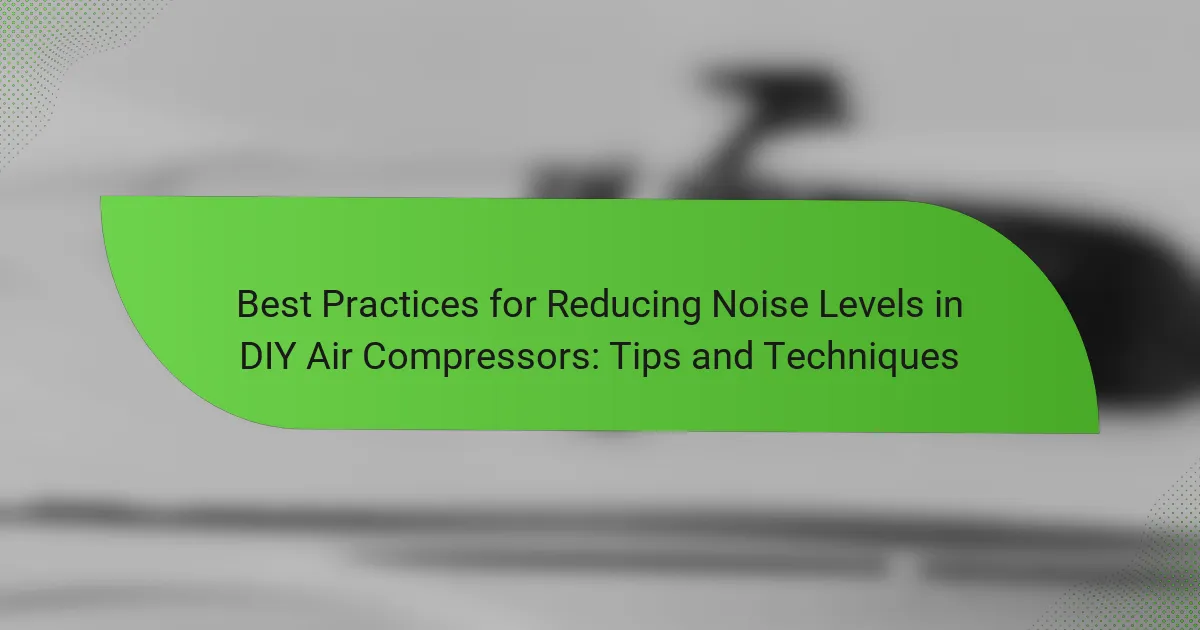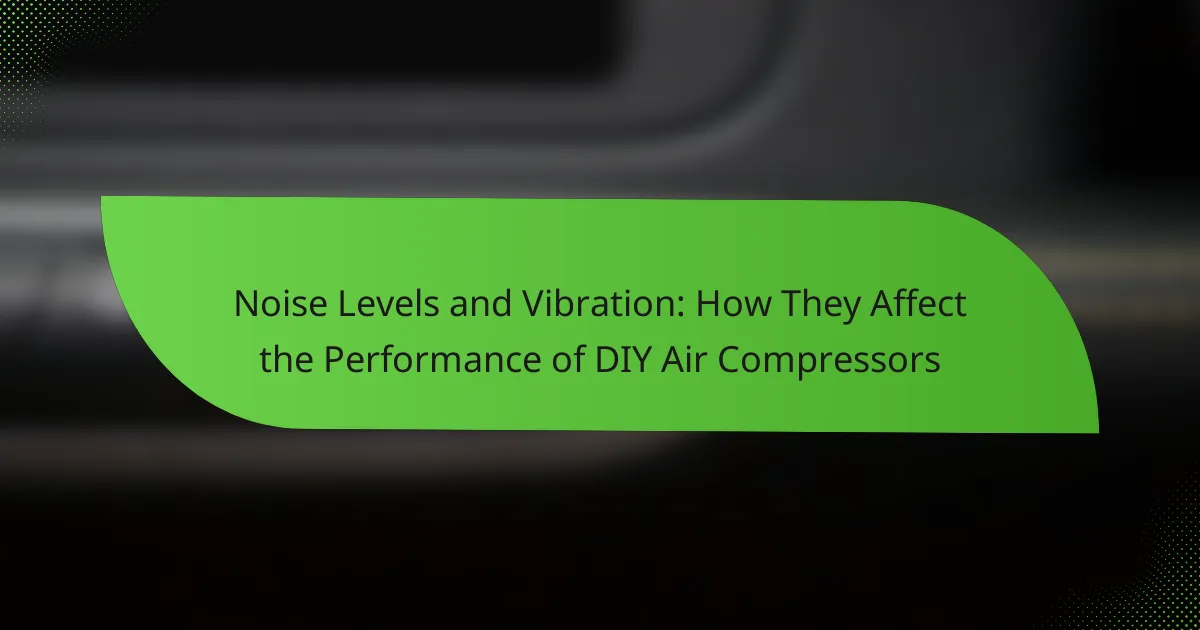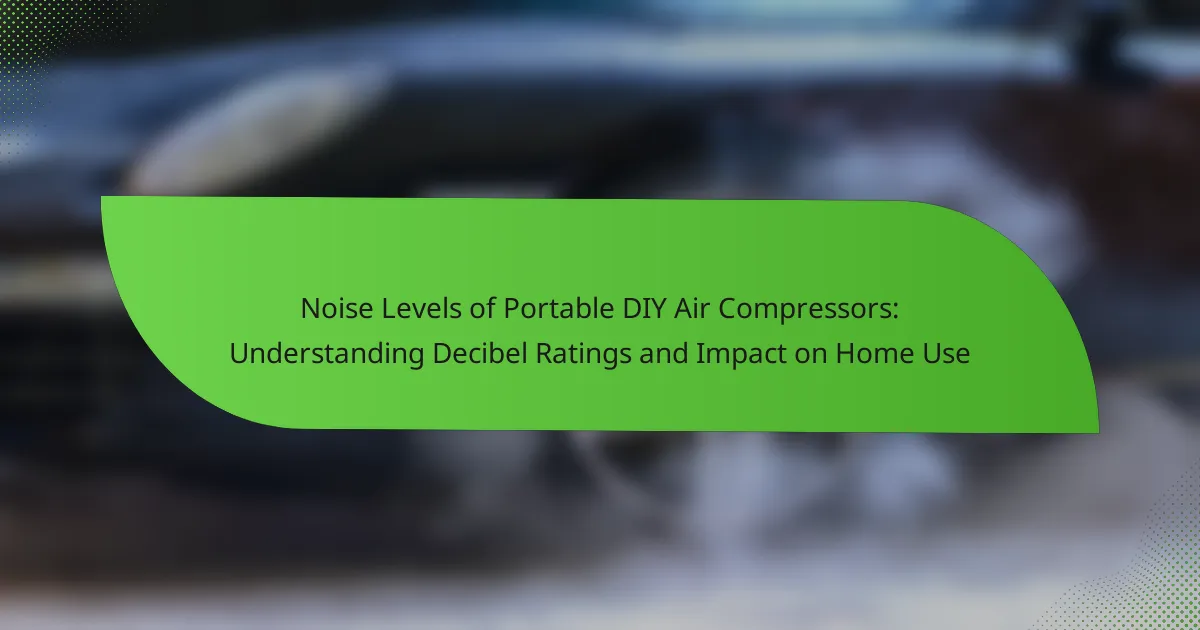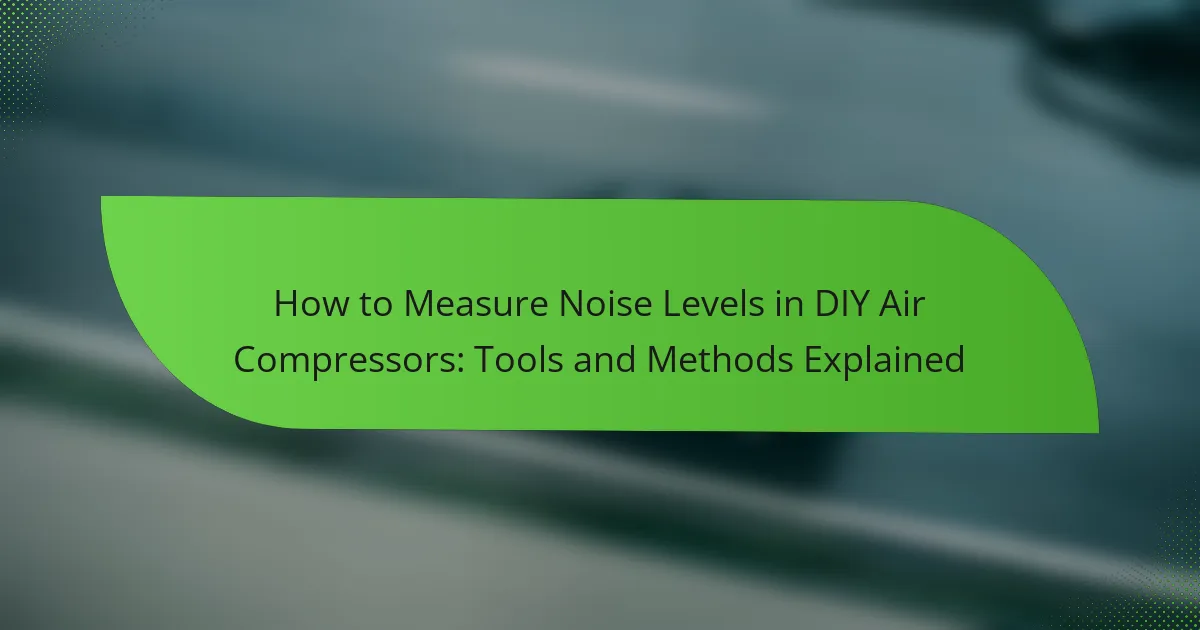This article evaluates the noise levels of DIY air compressors, focusing on key factors that influence sound output. The primary elements affecting noise include motor type, compressor design, and sound insulation materials. Electric motors generally produce less noise than gas-powered options, while oil-lubricated compressors operate more quietly than oil-free models. Techniques for measuring noise levels using sound level meters are outlined, emphasizing proper calibration and measurement conditions. Additionally, strategies for reducing noise, such as using sound insulation, vibration-dampening pads, and regular maintenance, are discussed to create a quieter operational environment for DIY air compressors.
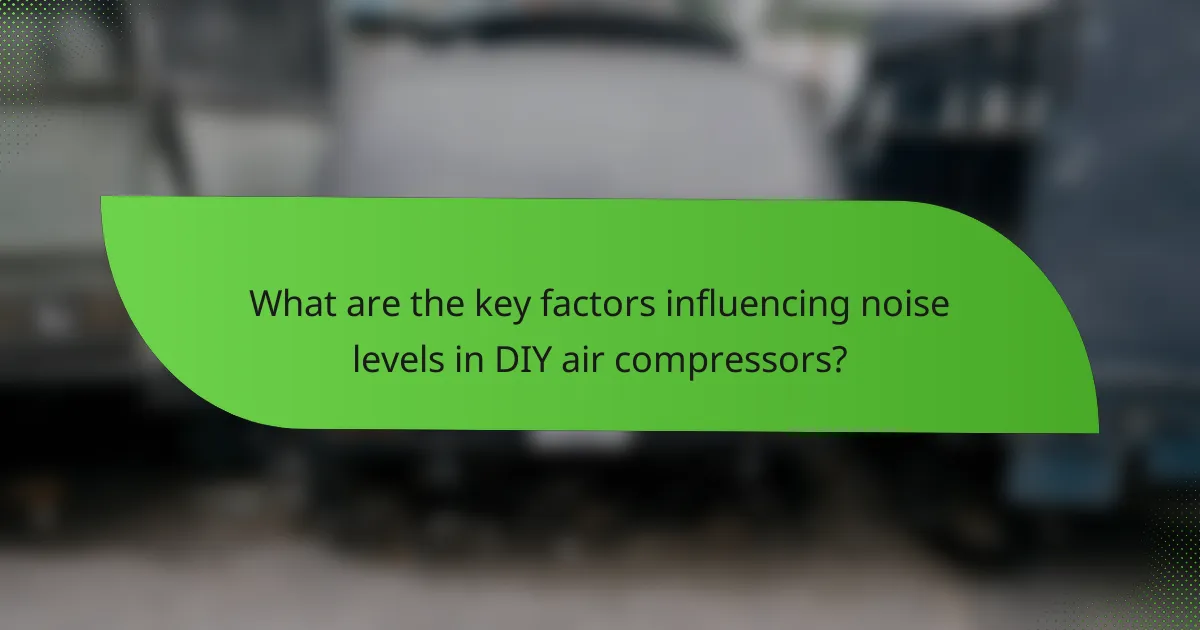
What are the key factors influencing noise levels in DIY air compressors?
The key factors influencing noise levels in DIY air compressors include the motor type, compressor design, and sound insulation. Electric motors typically produce less noise than gas-powered motors. The design of the compressor affects how sound is generated and transmitted. For instance, oil-lubricated compressors tend to operate more quietly than their oil-free counterparts. Additionally, the materials used in construction can dampen sound. Sound insulation features, such as enclosures or soundproofing materials, can significantly reduce noise output. Overall, these factors collectively determine the operational noise levels of DIY air compressors.
How do compressor types affect sound output?
Compressor types significantly influence sound output. Different compressor designs, such as reciprocating, rotary screw, and scroll compressors, produce varying noise levels. Reciprocating compressors often generate higher noise due to their mechanical components’ movement. Rotary screw compressors typically operate more quietly because of their continuous operation and fewer moving parts. Scroll compressors are usually the quietest, as they have a smooth operation with minimal vibration. Research indicates that noise levels can vary by up to 20 dB between these types. The choice of compressor type directly impacts the sound environment in which it operates.
What are the noise characteristics of different compressor types?
Compressor types exhibit distinct noise characteristics. Reciprocating compressors are typically louder, often producing noise levels between 70 to 90 decibels. This is due to their mechanical action and vibration. Rotary screw compressors generate moderate noise, usually around 60 to 80 decibels. They operate more smoothly, reducing vibration and noise. Scroll compressors are among the quietest, often emitting noise levels below 60 decibels. Their design minimizes moving parts, resulting in less vibration.
Noise levels can also be influenced by the compressor’s size and application. Larger compressors tend to produce more noise due to increased power output. Furthermore, enclosed designs can help reduce noise levels significantly. The specific noise characteristics of a compressor type are essential for evaluating their suitability for various environments.
How does the design of the compressor impact noise levels?
The design of the compressor significantly impacts noise levels. Compressors with sound-dampening features, such as insulated enclosures, reduce noise output. The shape and material of the compressor casing also influence sound transmission. Compressors designed with vibration isolation mounts minimize operational noise by absorbing vibrations. Additionally, the type of motor used can affect noise levels; quieter motors produce less sound. Studies indicate that compressors with optimized airflow designs operate more quietly due to reduced turbulence. Overall, thoughtful design choices directly correlate with lower noise emissions in compressors.
What role do motor specifications play in noise generation?
Motor specifications significantly influence noise generation in air compressors. The type of motor, its design, and power rating determine the sound levels produced. For instance, brushless motors are generally quieter than brushed motors. Additionally, the motor’s RPM (revolutions per minute) affects noise; higher RPMs often lead to increased noise levels. Motor housing materials also play a role; denser materials can dampen sound. Furthermore, motor size and weight can influence vibration, contributing to overall noise. Studies show that motors with lower power ratings tend to generate less noise. Therefore, selecting appropriate motor specifications is crucial for minimizing noise in DIY air compressors.
How do motor power ratings correlate with sound output?
Motor power ratings directly influence sound output in air compressors. Higher power ratings typically result in increased sound levels. This correlation occurs because more powerful motors generate greater mechanical energy. Increased mechanical energy often leads to higher operational speeds and vibrations. These factors contribute to louder sound emissions during compressor operation. Research indicates that compressors with power ratings above 3 HP produce sound levels exceeding 90 dB. This level is considered quite loud, impacting both user comfort and regulatory compliance. Thus, understanding motor power ratings helps in evaluating potential noise levels in DIY air compressors.
What is the impact of motor speed on noise levels?
Higher motor speed increases noise levels in air compressors. As the motor operates faster, it generates more vibrations and turbulence. This results in elevated sound output. Studies indicate that noise levels can rise significantly with increased RPM (revolutions per minute). For example, a motor running at 3,600 RPM can produce noise levels exceeding 85 dB. This is well above the recommended safe noise exposure levels. Therefore, motor speed directly correlates with noise intensity in air compressors.
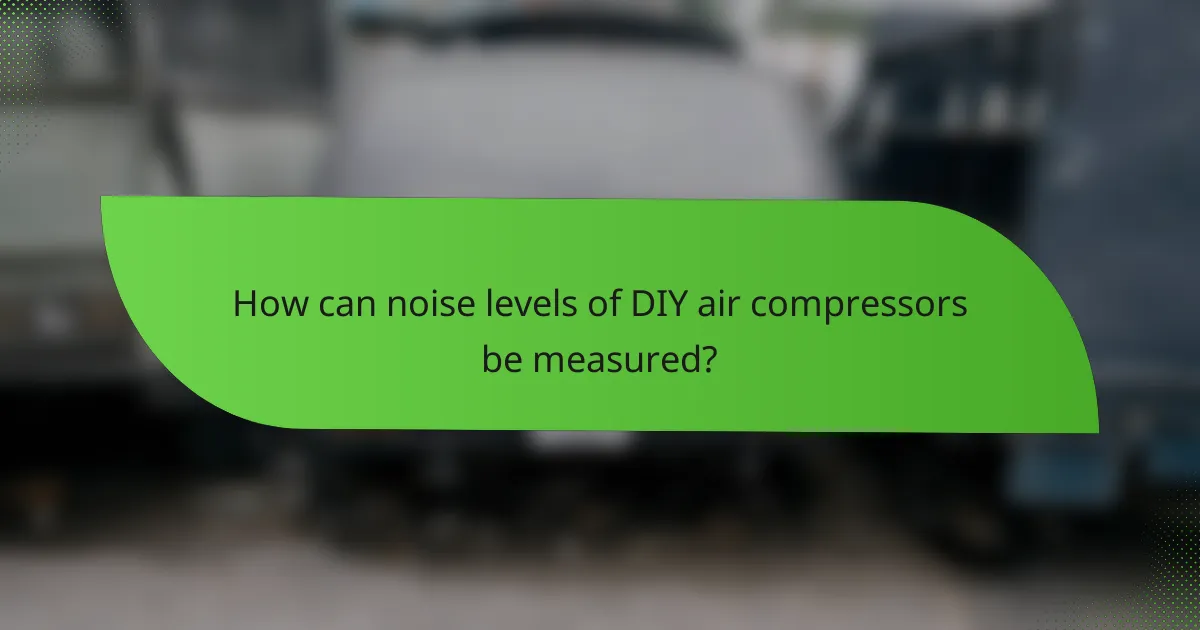
How can noise levels of DIY air compressors be measured?
Noise levels of DIY air compressors can be measured using a sound level meter. This device captures sound intensity in decibels (dB). To measure accurately, position the meter at a consistent distance from the compressor, typically one meter away. Ensure the compressor operates under typical load conditions during measurement. Record the maximum dB reading for precise data. Calibration of the sound level meter is crucial for accuracy. Many meters come with built-in calibration features to ensure reliability. Following these steps will yield a valid assessment of noise levels.
What tools are used for measuring compressor noise?
Sound level meters are the primary tools used for measuring compressor noise. These devices quantify the intensity of sound in decibels (dB). They provide accurate readings of noise levels produced by compressors during operation. Additionally, frequency analyzers can be utilized to assess specific sound frequencies emitted by compressors. These tools help in identifying problematic noise characteristics. Data loggers may also be employed to record noise levels over time. This allows for a comprehensive analysis of noise patterns. Using these tools ensures reliable measurement and evaluation of compressor noise levels.
How do decibel meters work in measuring sound levels?
Decibel meters measure sound levels by capturing sound waves and converting them into electrical signals. These meters use a microphone to detect sound pressure levels. The electrical signals are then processed to calculate the sound level in decibels (dB). Decibels are a logarithmic unit that expresses the ratio of a particular sound pressure to a reference level. Most decibel meters are calibrated to a reference sound pressure of 20 micropascals, which is considered the threshold of hearing. The meter’s display shows the sound level, allowing users to evaluate noise levels effectively. This method is widely used in various fields, including environmental monitoring and occupational safety, to assess noise exposure.
What are the best practices for accurate noise measurement?
The best practices for accurate noise measurement include using a calibrated sound level meter. A sound level meter should meet international standards such as ANSI S1.4. Position the meter at a consistent distance from the noise source, typically one meter. Ensure the microphone is at ear height for accurate readings. Conduct measurements in a controlled environment to minimize background noise. Take multiple readings to ensure reliability and average the results. Record environmental conditions, as temperature and humidity can affect measurements. Follow the manufacturer’s guidelines for the specific sound level meter used. These practices enhance the accuracy and reliability of noise measurements.
What are the standard noise level benchmarks for air compressors?
Standard noise level benchmarks for air compressors typically range from 60 to 90 decibels (dB). Compressors operating at 60 dB are considered relatively quiet, suitable for indoor use. Those at 70 dB are moderate and can be used in residential areas with some noise tolerance. High-performance compressors may reach levels of 80 to 90 dB, which can be disruptive in quiet environments. According to the American National Standards Institute (ANSI), noise levels above 85 dB can pose hearing risks with prolonged exposure. Thus, selecting an air compressor should consider both performance and noise output to ensure suitability for the intended environment.
How do different environments affect noise level perceptions?
Different environments significantly affect noise level perceptions. In open spaces, sound travels further and may seem less intrusive. Urban settings often amplify noise due to reflections from buildings. Conversely, quiet environments, like rural areas, can make even low sounds more noticeable. Acoustic properties of materials in a space also influence how sound is perceived. For instance, hard surfaces reflect sound, increasing perceived loudness. Studies show that ambient noise levels can alter human sensitivity to sound. Research indicates that background noise can mask other sounds, affecting perception. These factors collectively shape how individuals experience and interpret noise in varied environments.
What are the legal noise regulations for DIY air compressors?
Legal noise regulations for DIY air compressors vary by location. Many municipalities enforce noise ordinances that limit sound levels during specific hours. Commonly, permissible noise levels range from 55 to 70 decibels in residential areas. Some regions may require permits for equipment exceeding local noise limits. Compliance with Occupational Safety and Health Administration (OSHA) guidelines is also necessary in workplaces. Violations can result in fines or required modifications to equipment. Local regulations may be available through city or county government websites. Always check local laws for precise requirements.

What strategies can be employed to reduce noise levels in DIY air compressors?
To reduce noise levels in DIY air compressors, several strategies can be employed. First, using sound insulation materials around the compressor can significantly dampen noise. Acoustic foam or soundproofing panels can absorb sound waves. Second, placing the compressor on vibration-dampening pads minimizes vibrations that contribute to noise. Third, enclosing the compressor in a soundproof box can further reduce noise emissions. Fourth, regular maintenance, such as lubricating moving parts, can help minimize operational noise. Finally, selecting a compressor designed for quieter operation can also reduce overall noise levels. These strategies collectively contribute to a quieter DIY air compressor environment.
What modifications can be made to lower noise output?
To lower noise output from DIY air compressors, several modifications can be implemented. Installing rubber mounts can reduce vibrations that contribute to noise. Adding sound insulation materials around the compressor can absorb sound waves. Using a quieter motor or pump can significantly decrease operational noise levels. Implementing an acoustic enclosure can further contain sound emissions. Regular maintenance, such as lubricating moving parts, can help minimize noise from friction. Additionally, using a larger air tank can reduce the frequency of the motor cycling on and off, which lowers noise. These modifications have been shown to effectively reduce noise output in various DIY air compressor setups.
How does insulation impact compressor noise levels?
Insulation significantly reduces compressor noise levels. It acts as a barrier that absorbs sound waves generated by the compressor during operation. Effective insulation materials can lower decibel levels by up to 10-15 dB. This reduction makes the compressor less intrusive in residential or workshop environments. The type of insulation used, such as foam or mass-loaded vinyl, influences its effectiveness. Properly installed insulation also minimizes vibration transmission, further decreasing noise. Studies show that insulated compressors have lower perceived noise levels among users. Thus, insulation plays a vital role in enhancing the acoustic comfort of compressor operation.
What role do vibration dampeners play in noise reduction?
Vibration dampeners play a crucial role in noise reduction by minimizing vibrations produced by machinery. These devices absorb and dissipate energy from vibrations, preventing them from transferring to surrounding structures. By reducing the intensity of vibrations, they effectively lower the noise levels generated during operation. Studies show that implementing vibration dampeners can decrease noise output by up to 50%. This significant reduction enhances user comfort and compliance with noise regulations.
What are the best practices for operating air compressors quietly?
To operate air compressors quietly, choose a model designed for low noise output. Look for compressors with sound ratings below 70 dB. Install the compressor in a sound-insulated enclosure. Use vibration-dampening pads to minimize noise transmission. Maintain the compressor regularly to ensure efficient operation. Keep the air intake filter clean to reduce noise. Position the compressor away from work areas to limit sound exposure. Use longer hoses to increase distance from the noise source. These practices can significantly reduce operational noise levels.
How can placement of the compressor affect noise levels?
The placement of the compressor significantly affects noise levels. Compressors generate noise during operation due to mechanical vibrations and airflow. When placed on hard surfaces, vibrations transfer more effectively, increasing noise levels. Conversely, placing a compressor on a soft surface can dampen vibrations and reduce noise. Distance from walls or enclosed spaces also matters. Compressors near walls may reflect sound waves, amplifying noise. Additionally, placing a compressor in a soundproofed area can significantly lower perceived noise levels. Research indicates that sound levels can vary by up to 10 decibels based on placement choices. This variation is crucial for users concerned about noise pollution.
What tips can help minimize noise during operation?
Use soundproofing materials to reduce noise during operation. Acoustic panels can absorb sound waves effectively. Installing vibration-dampening pads under the compressor minimizes vibrations that contribute to noise. Regular maintenance of the compressor ensures it operates efficiently and quietly. Keeping the compressor in a well-ventilated area can also help, as overheating can increase noise levels. Using a quieter model or an enclosed design can significantly decrease operational noise. These methods can reduce noise levels by up to 50%, enhancing user comfort.
The main entity of this article is DIY air compressors, with a focus on the factors influencing their noise levels. Key aspects discussed include the impact of motor type, compressor design, and sound insulation on sound output. The article examines how different compressor types, such as reciprocating, rotary screw, and scroll compressors, produce varying noise levels, and highlights the role of motor specifications and speed in noise generation. Additionally, it covers measurement techniques for noise levels, best practices for quiet operation, and strategies to reduce noise emissions effectively.
